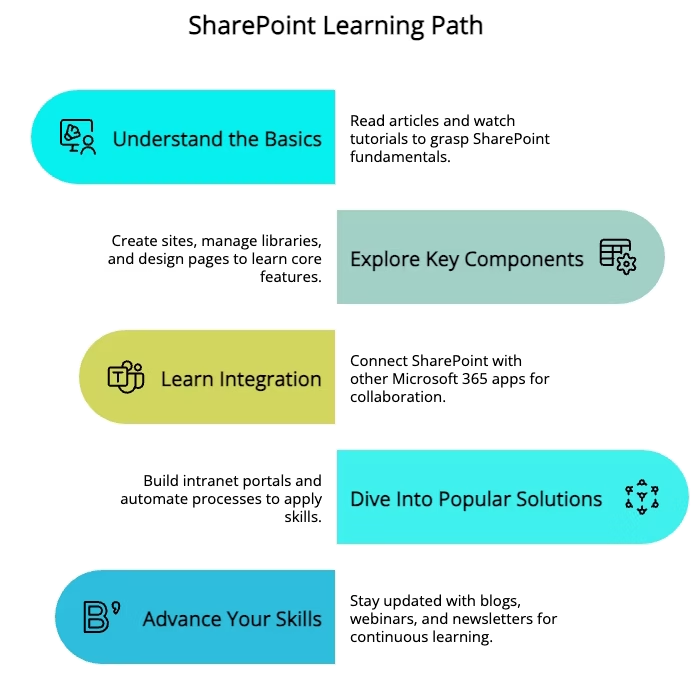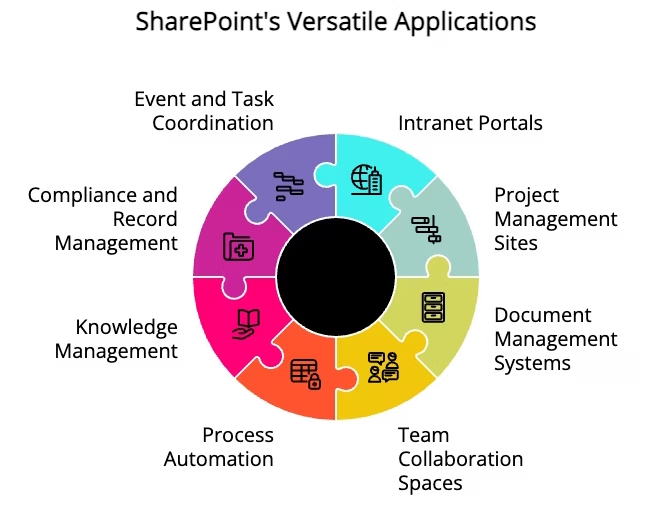


Are you new to SharePoint and unsure where to start? This beginner’s guide will help you understand its core components and purpose. SharePoint is one of the most powerful tools in the Microsoft 365 suite, designed to streamline collaboration, document management, and communication for teams and organisations. Whether you’re entirely new to SharePoint or just beginning to explore its capabilities, understanding the basics is key to unlocking its potential.
This guide will cover what SharePoint is, why it’s essential, its main features, and a clear learning path to help you get started.
Get My Best SharePoint Tips (and Two Free Guides)
Join 1,000+ readers and get the SharePoint Quick Start Guide and the Microsoft 365 Collaboration Guide (normally $19) instantly — plus a new freebie every Friday.
Subscribe & Get the Free GuidesWhat is SharePoint For?
At its core, SharePoint is a web-based platform that enables teams to:
-
- Collaborate effectively: Share files, ideas, and updates in real-time.
-
- Centralise resources: Store, organise, and access documents and information from anywhere.
-
- Streamline workflows: Automate repetitive tasks and approvals.
-
- Improve communication: Keep everyone informed with news, announcements, and events.
Whether you’re managing projects, sharing files, or creating a company-wide intranet, SharePoint provides the tools you need to keep everything connected and organised.
Why Use SharePoint?
SharePoint is flexible and designed to adapt to your team’s needs, offering:
-
-
Accessibility: Access your content securely from any device, anywhere in the world.
-
-
-
Scalability: Whether you’re a small team or a global organisation, SharePoint can grow with you.
-
-
-
Integration: Seamlessly connect with Microsoft 365 apps like Teams, Outlook, and OneDrive for a unified experience.
-
-
-
Efficiency: Save time by centralising information and automating tasks.
-
-
-
Security: Keep sensitive data protected with robust permission controls.
-
Key Components of SharePoint
SharePoint offers a variety of features, but these foundational components will help you get started:
Sites
SharePoint sites are like digital workspaces tailored to specific teams, departments, or projects. They provide a structure for organising files, hosting news, and managing resources.
Document Libraries
A cornerstone of SharePoint, document libraries are where you store, organise, and collaborate on files. With version control, metadata, and views, they’re designed to simplify document management.
Lists
Think of lists as customisable tables to manage information like tasks, contacts, or inventory. They integrate seamlessly with other Microsoft 365 tools for automation and reporting.
Pages
SharePoint pages help you share information visually, whether it’s news updates, dashboards, or instructions. Use web parts to add content like text, videos, or quick links to your page.
Metadata and Views
Metadata helps categorise and tag your files for better organisation and searchability. Custom views allow you to display only the information you need, saving time and reducing clutter.
Popular Solutions and Ways SharePoint is Used
SharePoint’s flexibility allows it to be used in many creative and effective ways. Here are some of the most popular solutions organisations implement using SharePoint:
Intranet Portals
-
Create a central hub for company-wide announcements, policies, and resources.
-
Encourage employee engagement with newsfeeds, event calendars, and recognition pages.
Project Management Sites
-
Manage tasks, timelines, and project updates in a single location.
-
Use lists and document libraries to track project deliverables and share resources.
Document Management Systems (DMS)
-
Store, organise, and manage critical business documents.
-
Leverage version control to ensure everyone is working on the latest file.
Team Collaboration Spaces
-
Provide teams with dedicated workspaces for sharing files, ideas, and updates.
-
Integrate with Teams for seamless collaboration.
Process Automation
-
Automate repetitive workflows like leave requests, expense approvals, or document reviews.
-
Use Power Automate to extend SharePoint’s automation capabilities.
Knowledge Management
-
Build a repository of training materials, guides, and best practices.
-
Enhance searchability with metadata and tags.
Compliance and Record Management
-
Maintain regulatory compliance by managing sensitive documents with permissions and retention policies.
-
Use audit logs to track activity and ensure accountability.
Event and Task Coordination
-
Schedule events, assign tasks, and track progress with integrated tools like calendars and lists.A Beginner’s Learning Path for SharePoint
To help you get started with SharePoint, here’s a step-by-step learning path:

Understand the Basics
-
Read introductory articles and watch beginner-friendly tutorials.
-
Familiarise yourself with the SharePoint interface and navigation.
-
Explore the purpose of SharePoint, including how organisations use it for intranets, document management, and collaboration.
Explore Key components
-
Create a SharePoint site and experiment with different site templates to learn their features.
-
Set up and manage document libraries, including adding, organising, and sharing files.
-
Create and customise lists for tracking tasks, events, or data.
-
Design pages with web parts to display news, reports, and other content.
-
Implement metadata and create custom views to improve organisation and search functionality.
Learn Integration
-
Connect SharePoint to Microsoft Teams to create a collaborative workspace with shared files.
-
Sync SharePoint document libraries with OneDrive for offline access.
-
Explore integration options with other Microsoft 365 apps like Planner, Power BI, and Outlook.
Dive Into Popular Solutions
-
Build a basic intranet portal, including a homepage with links to key resources and tools.
-
Create a project management site with task lists, document libraries, and calendar web parts.
-
Automate simple processes using built-in workflows or Power Automate to streamline approvals or notifications.
Advance Your Skills
-
Stay Updated
-
Follow SharePoint blogs (like mine) and forums for expert advice and solutions to common challenges.
-
Attend webinars or Microsoft events to learn about new features and updates.
-
Subscribe to newsletters or YouTube channels focused on SharePoint best practices and tips.
Your Next Step
Ready to master SharePoint from the ground up?
The SharePoint Essentials Course ($67) is the complete beginner's course that takes you from confused to confident in just 60 minutes — using the Container Method™ framework that finally makes SharePoint make sense.
- 12 video lessons (60 minutes total)
- Container Method™ framework for instant clarity
- Real-world examples + hands-on exercises
- Workbook and templates included
- Lifetime access with future updates
Over 500 beginners have taken this course and finally “clicked” with SharePoint. Join them.
Enroll in SharePoint Essentials for $67 →
Hi, I'm Liza 👋
I've been working with SharePoint since 2005, and nothing excites me more than diving into a messy SharePoint environment and transforming it into something streamlined and intuitive.
I created Simply SharePoint to share practical, real-world advice for end users, managers, and teams who need more than just basic tutorials. My focus is on information architecture, out-of-the-box solutions, and making Microsoft 365 work the way it should—without the jargon.
When I'm not fixing SharePoint chaos, you'll find me exploring the city with my daughter, enjoying live music, or indulging my passion for fashion and bold color (which you might notice in my brand!).
Ready to make SharePoint make sense? Get my free Quick Start Guide and join 1,000+ professionals learning inside Simply SharePoint.
Get the Free Quick Start Guide + a surprise freebie →



